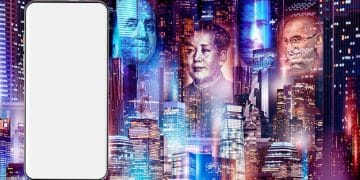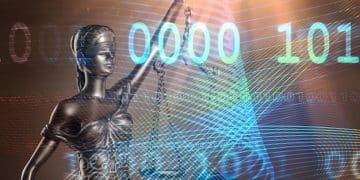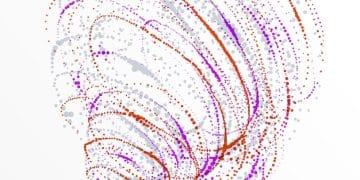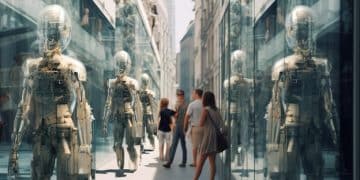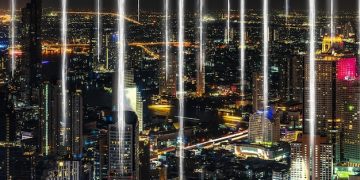AI-Generated Art and Music: Copyright Implications in the US
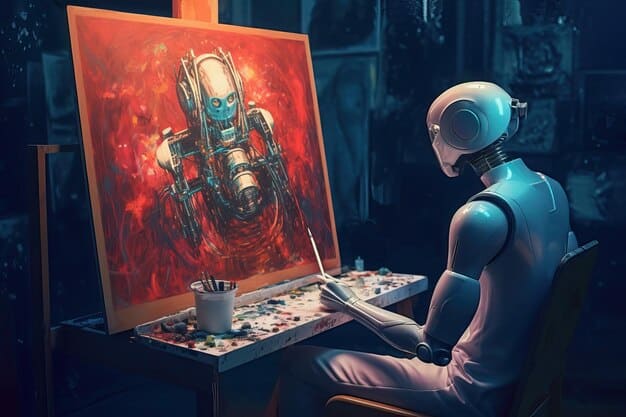
AI-generated art and music raise complex copyright questions in the US, particularly regarding authorship, ownership, and the use of copyrighted training data, necessitating a careful examination of existing laws and potential legislative updates.
The emergence of AI-generated art and music is rapidly transforming creative industries, but it also introduces a complex web of copyright implications in the US that need careful consideration.
AI and Copyright Law: An Introduction
The intersection of artificial intelligence and copyright law presents unique challenges. As AI becomes more sophisticated, its ability to generate original content blurs the lines of traditional authorship and ownership, necessitating a closer look at how existing laws apply.
Understanding these nuances is crucial for artists, developers, and legal professionals alike, as the legal landscape surrounding AI-generated works continues to evolve.
The Question of Authorship
A central question is who can claim authorship of AI-generated works. Under current US copyright law, authorship is generally attributed to human creators. But what happens when an AI creates a piece of art or music autonomously?
The Copyright Office has generally maintained that copyright protection requires human authorship. The AI itself cannot be the author, raising questions about who, if anyone, holds the copyright to these works.
Copyright Office Guidelines
The US Copyright Office has issued guidelines stating that it will not register works created solely by artificial intelligence. This stance reinforces the requirement of human authorship as a prerequisite for copyright protection.
- Human Intent: The degree of human involvement and creative intent is crucial.
- AI as a Tool: AI is often viewed as a tool, much like a paintbrush or musical instrument, with the human artist retaining control.
- Copyright Rejection: Works generated entirely by AI without human intervention are likely to be rejected for copyright registration.
In conclusion, the Copyright Office emphasizes the necessity of human authorship for copyright protection, influencing the legal framework surrounding AI-generated art and music.
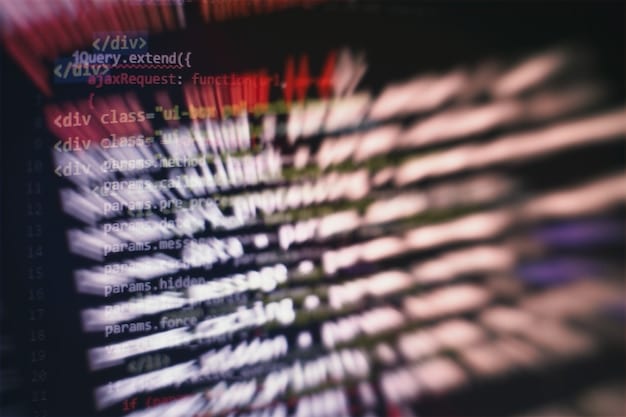
Copyright Ownership of AI-Generated Content
Determining ownership of AI-generated content is another critical aspect of copyright law. When an AI creates a piece of art or music, the question arises: who owns the copyright to that work?
The answer often depends on the level of human involvement in the creative process. If a human provides significant creative input, they may be able to claim ownership.
Human Input vs. AI Output
The distinction between human input and AI output is crucial in determining copyright ownership. If a human provides detailed instructions and creative direction, they are more likely to be considered the author and owner of the copyright.
However, if the AI generates the work autonomously with minimal human intervention, the question of ownership becomes more complex.
Factors Influencing Ownership
- Extent of Human Control: The more control a human exercises over the AI, the stronger their claim to ownership.
- Originality of Input: The originality of the human’s input is also a factor. Merely prompting the AI may not be enough.
- Clarity of Agreement: If multiple parties are involved (e.g., developer, user), clear agreements regarding copyright ownership are essential.
In summary, copyright ownership of AI-generated content largely hinges on the degree of human involvement and control in the creative process, necessitating careful consideration of these factors.
Fair Use and Training Data
One of the biggest legal challenges in AI-generated art and music involves the use of copyrighted material in training data. AI models are trained on vast datasets, often containing copyrighted works. This raises questions about fair use and potential copyright infringement.
Understanding the boundaries of fair use in the context of AI training data is essential for developers and artists alike, as it affects the legality of AI-generated outputs.
The Fair Use Doctrine
The fair use doctrine allows the use of copyrighted material without permission for certain purposes, such as criticism, commentary, news reporting, teaching, scholarship, and research. Whether the use of copyrighted data for AI training qualifies as fair use is a subject of ongoing debate.
The four factors of fair use, as outlined in Section 107 of the Copyright Act, are weighed to determine whether a particular use is fair. These factors include the purpose and character of the use, the nature of the copyrighted work, the amount and substantiality of the portion used, and the effect of the use upon the potential market for or value of the copyrighted work.
Legal Disputes and Precedents
Several legal disputes have arisen over the use of copyrighted material in AI training data. These cases seek to clarify the boundaries of fair use and determine whether AI developers are liable for copyright infringement.
- Google Books: The Google Books case set a precedent for transformative use in large-scale digitization projects.
- Authors Guild vs. Google: This case addressed fair use in the context of digital libraries and search functionality.
- Ongoing Litigation: Current lawsuits involving AI training data may set new legal precedents.
Ultimately, the question of fair use in AI training data remains a contentious issue with potentially significant implications for the future of AI-generated content.
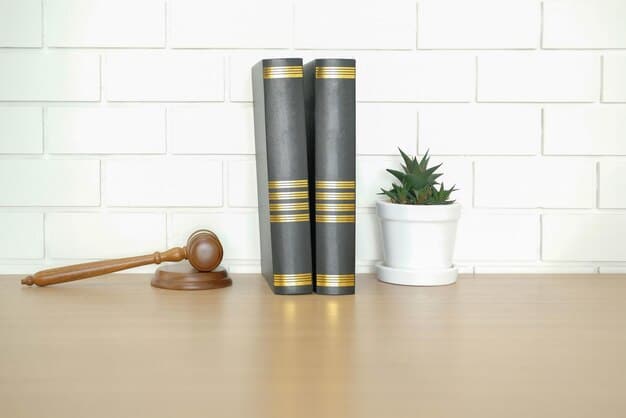
The Role of AI Developers
AI developers play a crucial role in shaping the legal landscape of AI-generated art and music. Their actions and choices can significantly impact copyright implications.
Understanding their responsibilities and potential liabilities is essential for fostering responsible innovation.
Transparency and Accountability
Transparency in AI development is becoming increasingly important. Developers should be transparent about the data used to train their AI models and the algorithms used to generate content.
Accountability is also crucial. Developers may be held liable for copyright infringement if their AI models generate content that infringes on existing copyrights.
Strategies for Mitigation
- Data Licensing: Obtaining licenses for copyrighted material used in training data can help mitigate legal risks.
- Algorithmic Design: Designing algorithms that minimize the risk of infringement is also important.
- Terms of Service: Clear terms of service can define the rights and responsibilities of users and developers.
In light of this, AI developers must adopt responsible practices to navigate the complex legal landscape and minimize the risk of copyright infringement.
International Perspectives on AI and Copyright
Copyright laws pertaining to AI-generated works vary significantly across different countries. Examining international perspectives can provide valuable insights into alternative approaches and potential future directions.
Understanding how other jurisdictions address these issues can inform policy discussions and legal strategies in the US.
Comparative Analysis
Several countries have already grappled with the copyright implications of AI-generated content. A comparative analysis reveals a range of approaches, from strict adherence to traditional authorship requirements to more flexible interpretations.
Some countries have introduced new legislation specifically addressing AI-generated works, while others rely on existing copyright laws.
Examples from Around the World
- United Kingdom: The UK has a more lenient approach, granting copyright to the person who made the arrangements necessary for the creation of the work.
- European Union: The EU is considering new regulations to address the copyright implications of AI.
- Japan: Japan does not grant copyright to AI-generated works, but it also does not prohibit their use.
Examining international approaches can help inform discussions about how to best address the copyright implications of AI-generated art and music in the US.
Future Trends and Legal Reforms
As AI technology continues to advance, the legal landscape surrounding AI-generated art and music is likely to evolve. Anticipating future trends and potential legal reforms is essential for stakeholders.
Staying informed about emerging technologies and legal developments can help artists, developers, and legal professionals navigate the evolving landscape.
Emerging Technologies
Advances in AI technology are constantly pushing the boundaries of what is possible. New AI models are capable of generating increasingly sophisticated and original content.
These technological advancements will continue to challenge existing copyright laws and raise new legal questions.
Potential Legal Reforms
- New Legislation: Congress may consider new legislation to address the copyright implications of AI-generated works.
- Copyright Office Guidance: The Copyright Office may issue updated guidance to clarify its position on AI authorship and ownership.
- International Agreements: International agreements may be needed to harmonize copyright laws across borders.
In conclusion, the future of copyright law in the age of AI is uncertain, but proactive engagement and informed decision-making are crucial for shaping a fair and sustainable legal framework.
| Key Point | Brief Description |
|---|---|
| 💡 Authorship & AI | US Copyright law typically requires human authorship for copyright protection. |
| ⚖️ Fair Use | The use of copyrighted data for AI training is debated under the fair use doctrine. |
| 🌏 Global Views | Copyright laws for AI content vary significantly internationally. |
| 🤖 AI Developers | AI developers have transparency and accountability regarding copyright. |
Frequently Asked Questions
▼
No, according to the US Copyright Office, AI cannot be considered an author. Copyright protection requires human authorship, meaning a work must be created by a human being to be eligible for copyright.
▼
If a human provides significant creative input, they may be able to claim ownership. The extent of human control, originality of input, and agreements between parties involved are critical factors in determining ownership.
▼
Whether using copyrighted data for AI training qualifies as fair use is an ongoing debate. The four factors of fair use are weighed to determine fairness, and legal disputes continue to shape precedents.
▼
AI developers must be transparent about training data and algorithms to minimize infringement risks. Strategies for mitigation include data licensing, algorithmic design, and clear terms of service to protect copyright.
▼
International copyright laws vary, with some countries like the UK granting copyright to those arranging the work’s creation. The EU considers new AI regulations, while Japan doesn’t grant or prohibit AI-generated works, showing diverse approaches.
Conclusion
In conclusion, the intersection of AI and copyright law presents significant challenges and opportunities. As AI technology advances, it is crucial to address the evolving legal issues surrounding AI-generated art and music to ensure a fair and innovative environment for creators and developers alike.
